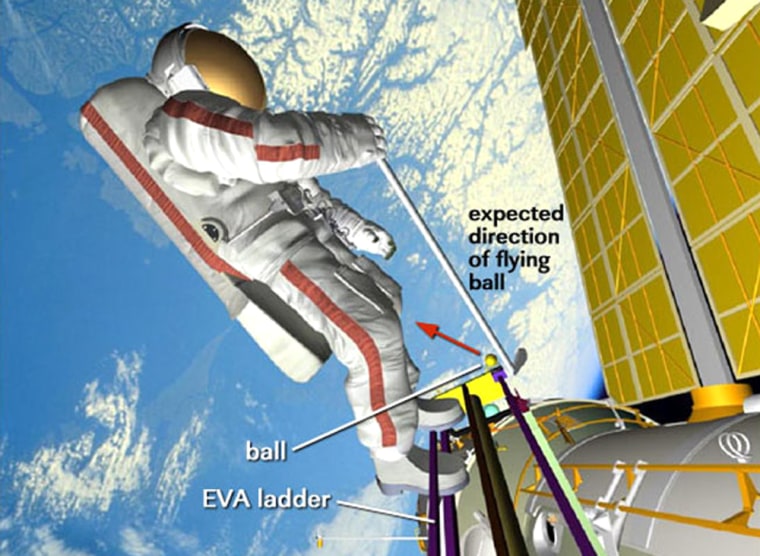A veteran spacewalker — but novice golfer — took a golf shot seen around the world on Wednesday as part of a publicity stunt at the international space station.
Russian cosmonaut Mikhail Tyurin took a one-handed tap at a foam-rubber ball with a 6-iron at the beginning of a 5½-hour spacewalk, with NASA astronaut Michael Lopez-Alegria serving as his caddy. After the stunt, the two quickly moved on to their other tasks, including work on space station antennas and a science experiment.
Golf fans had a less than perfect view.
The main cameras on the station could get only a distant shot of the Russian side of the space station, where the stunt was taking place. Lopez-Alegria set up a special camera to record the shot for Element 21 Golf, the Canadian golf club maker paying for the promotion, but that imagery wouldn't be downloaded until later.
During the preparations, Russian mission controllers cautioned Tyurin to place the ball correctly on a special springlike tee.
"The ball is the least of our concerns," Tyurin joked. "It's me who has to be positioned properly."
Tyurin had to anchor his feet under a ladder in order to set up for the shot — which proved challenging, even with Lopez-Alegria's help. "My legs are drifting away," Tyurin complained at one point.
But with only a couple of minutes left in their video downlink opportunity, Tyurin steadied himself and teed off.
‘It went pretty far’
"Ready, set, assume the position, the way it should be," he told Mission Control in Russian. "All right, there it goes — and it went pretty far. It was an excellent shot."
The spacewalkers watched the vanishing white dot as it sailed earthward.
"You got a hold of that one," Lopez-Alegria commented.
Tyurin, who was coached on his role by pros during his training back on Earth, may have "shanked the ball a bit," said NASA spokesman Rob Navias. The ball went off to the right side of the space station, but did no damage.

Tyurin had three of the specially made golf balls at the ready, which could have allowed him to take a mulligan. But it turned out that his first shot was the only shot. Russian controllers told him to put the equipment away and proceed with the spacewalk's other tasks.
The spacewalkers repositioned an antenna that will be used by European cargo spaceships starting next year. They also installed a solar-flare experiment on the top of the Zvezda service module.
But Tyurin and Lopez-Alegria weren't able to retract a navigational antenna on a Progress cargo craft attached to the station. The stuck part wouldn't budge, and the job had to be set aside for a future spacewalk. "No movement whatsoever," Tyurin grumbled.
Glitches also bedeviled the spacewalk's beginning. The start was delayed by more than an hour — at first because Tyurin had a kink in a cooling hose on his spacesuit, and then because the astronauts encountered snags while opening the hatch. Controllers pressed the spacewalkers to finish up early, and the spacewalk ended up lasting five hours and 38 minutes — about 20 minutes less than originally scheduled.
Undisclosed sum paid
Element 21 paid an undisclosed sum to the Russians for Wednesday's stunt, which company officials said commemorated the 35th anniversary of astronaut Alan Shepard’s memorable golf swing on the moon during the Apollo 14 mission in 1971.
It follows other commercial ventures at the space station that the Russian space agency has allowed, sometimes to the chagrin of NASA. The cash-strapped Russians have allowed Pizza Hut to paint its logo on a rocket and have a pizza delivered to the space station. And it once charged PepsiCo $5 million to have cosmonauts float a replica of a soda can outside the Mir space station.
NASA has taken a grin-and-bear-it attitude. The U.S. space agency is indebted to its Russian partner for flying U.S. astronauts to the space station while shuttles were grounded after the Columbia disaster.
Safety first
The orbital ball was made from foam rubber and weighed only 3 grams — about one-fifteenth the mass of a normal golf ball — to minimize any damage in case it actually struck something. The same safety concerns dictated that Tyurin give the ball just a tap rather than a full-fledged drive. And the reason for the one-handed swing was that Tyurin's spacesuit was too stiff to accommodate a two-handed grip.
Slideshow 12 photos
Month in Space: January 2014
The ball was struck toward Earth, but because it and the space station are whizzing around the planet at a speed of more than 17,000 mph (27,300 kilometers per hour), its trajectory won't be straight down. Rather, it will follow a gradually decaying orbit.
NASA predicts the ball will re-enter Earth's atmosphere in three days — traveling a little more than a million miles (1.8 million kilometers) in the process. Russian controllers told Tyurin that the ball might stay up for four days.
"Oh, not four days!" Tyurin replied. "It's probably going to fly all the way to the moon."
Element 21 was similarly optimistic, saying that the ball could stay in orbit for as long as four years and travel as far as a billion miles.
In any case, NASA says the ball shouldn't pose a threat to either the space station or the shuttle Discovery, set to launch Dec. 7.
This report includes information from The Associated Press.
